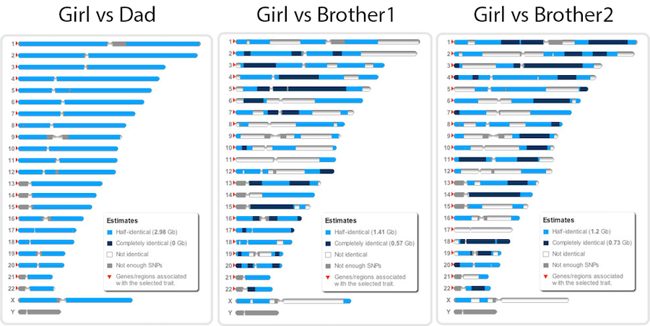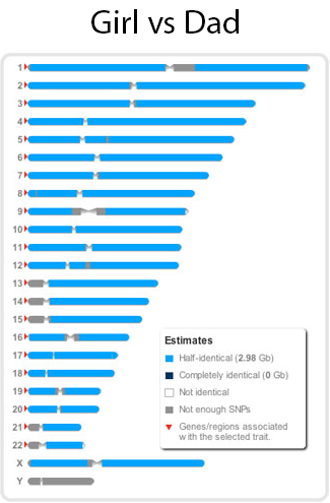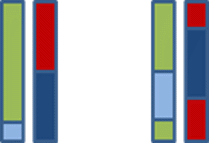
Would a paternity test have trouble telling a brother/sister apart from a mother/son?
January 30, 2013

- Related Topics:
- Consumer genetic testing,
- Ancestry tests,
- Paternity tests,
- Relatedness
A curious adult from Ireland asks:
"I have heard that a paternity test would have trouble telling a brother/sister relationship from a mother/son one. Is that true? If so, why is that? And are there any tests that could tell the two apart?"
You have heard right. If you just test the two people, a run-of-the-mill paternity test would indeed have trouble telling a mother and son apart from a brother and sister. Testing more relatives would help but still might not be enough.
The reason a paternity test can’t tell which relationship is right is that it looks at too little DNA. In fact, it may have trouble telling that the two people are brother/sister even if they are!
Of course the obvious answer is to look at more DNA. But until recently, that was way too expensive. This is no longer true.
For very little money, you can now look at a million different spots on your DNA instead of the 20 or maybe 30 that is looked at in a conventional test. And as you’ll see below, this is enough to tell whether a man and woman are brother/sister or son/mother.
Two Halves Aren’t Always Equal
What I thought I would do is cut right to the chase and show you what the results would look like for a son versus a brother with one of these more extensive tests. These are actual results from a company called 23andMe.
One more thing. This is comparing a woman to her two brothers and her father (but the exact same ideas hold for a man versus sisters and a mother). For ease we’ll just ignore the X and the Y.

Now it is pretty obvious that this test can tell the difference between a parent/child relationship and a sibling one. The parent is all light blue (except where there isn’t any data from the test) and the brothers are a mishmash of white, light blue and black. So if someone has this test done, it will be pretty obvious if their DNA is being compared to a parent or a sibling.
What I’ll do for the rest of the answer is try to explain why we get these results. As you’ll see, it has to do with the fact that each of us has two sets of chromosomes (one from mom and one from dad). And with something called recombination.
Parents First
OK let’s start out with the easier of the two. Here is the parent/child comparison again:

This is a comparison of the daughter’s DNA to her father. As you can see, the test results are that the two are half identical everywhere the test could get reliable data. To understand what that means, let’s take a step back and go over how DNA is passed from parent to child.
We get half our DNA from our mom and half from our dad. This DNA is passed down in the form of chromosomes.
Most people have two sets of 23 chromosomes for a total of 46. One set comes from mom and the other from dad.
Here is what that might look like for a mother and father passing their DNA down to their child:

There is a lot going on here but let’s take this one step at a time. First off, we’ll focus on just mom’s contribution.
You may notice that mom doesn’t pass either her blue or green chromosome from each pair. Instead, she passes a chromosome that is a mixture of the two. This process, called recombination, means that the child has a brand new, never before seen chromosome. This will be important for the next section.
What we can definitely say is that one of each pair of chromosomes comes from mom and one of each pair comes from dad. So why does the test call this half identical? It has to do with a limitation of the test itself.
See, the test can see big swaths of DNA but it can’t tell which parts are on which chromosomes. What this means is that it can’t tell the difference between any of these:

In the test, all five of these kids would be termed half identical. Each one has a chromosome that completely matches a part of one of mom’s chromosomes. The other chromosome (the colorless one from dad) doesn’t match either of mom’s chromosomes. And so the child is half identical with mom at this chromosome.
This will be true of all of the child’s chromosome pairs. All of them will be half identical with mom.
OK now let’s tackle siblings. As you’ll see, that recombination we talked about earlier is really important for this part.
Degrees of Identicality
Here is what the result looked like for one brother:

This is very different from the all blue of the parent comparison. Let’s look at one chromosome pair in two siblings to see why the result looks like this:

In this picture, mom’s light blue and green chromosomes are on the left and dad’s red and dark blue chromosomes are on the right. Each child gets a chromosome from mom that is part green and part light blue. And each child gets a chromosome from dad that is part red and part dark blue.
What’s important here is that each child got different parts of mom’s chromosomes and different parts from dad’s. Let’s take a closer look at the two siblings’ chromosome pairs. First we’ll line them up:

Now we will box in areas where they are the same across both chromosomes (completely identical), where they match up at one chromosome (half identical) and where they don’t match at all (not identical). Here is what that would look like:

As you can see, at the top of this chromosome pair, they both have green on one chromosome and red on the other. They completely match. In the middle they only match at one of the two chromosomes and at the bottom they don’t match at all. Here is what this would look like in the 23andMe test results:

Remember, black is completely identical, blue is half identical and white is not identical at all. Now the chromosomes are displayed on their side so it would look more like this:
![]()
Now let’s go back to the original results:

If the results are half identical everywhere, odds are we are comparing a parent to child. If on the other hand you have a mix of completely, half and not identical, we are looking at a sibling relationship.
To end things, I thought I’d give what a couple of other relationships look like. Enjoy!


Author: Dr. D. Barry Starr
Barry served as The Tech Geneticist from 2002-2018. He founded Ask-a-Geneticist, answered thousands of questions submitted by people from all around the world, and oversaw and edited all articles published during his tenure. AAG is part of the Stanford at The Tech program, which brings Stanford scientists to The Tech to answer questions for this site, as well as to run science activities with visitors at The Tech Interactive in downtown San Jose.
 Skip Navigation
Skip Navigation
